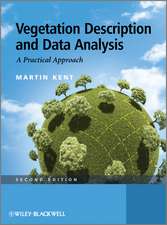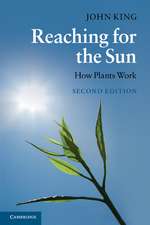Biophysical Techniques in Photosynthesis: Volume II: Advances in Photosynthesis and Respiration, cartea 26
Editat de Thijs Aartsma, Jörg Matysiken Limba Engleză Hardback – 13 feb 2008
The contributions are written by leading scientists in their field. The book is divided into 5 sections on Imaging, Structure, Optical and laser spectroscopy, Magnetic resonance and on Theory, respectively. Each chapter describes the basic concepts of the technique, practical applications and some of the scientific results. Possibilities and limitations from a technical as well as a scientific point of view are addressed, allowing the reader not only to recognize the potential of a particular method for his/her own quest, but to assess the resources that are required for implementation.
| Toate formatele și edițiile | Preț | Express |
|---|---|---|
| Paperback (1) | 1245.22 lei 6-8 săpt. | |
| SPRINGER NETHERLANDS – 23 noi 2010 | 1245.22 lei 6-8 săpt. | |
| Hardback (1) | 1095.64 lei 38-44 zile | |
| SPRINGER NETHERLANDS – 13 feb 2008 | 1095.64 lei 38-44 zile |
Din seria Advances in Photosynthesis and Respiration
- 24%
 Preț: 1620.59 lei
Preț: 1620.59 lei - 18%
 Preț: 2566.01 lei
Preț: 2566.01 lei - 18%
 Preț: 1397.68 lei
Preț: 1397.68 lei - 18%
 Preț: 1855.74 lei
Preț: 1855.74 lei - 18%
 Preț: 1850.52 lei
Preț: 1850.52 lei - 24%
 Preț: 1053.59 lei
Preț: 1053.59 lei - 24%
 Preț: 1601.81 lei
Preț: 1601.81 lei - 24%
 Preț: 1596.44 lei
Preț: 1596.44 lei - 18%
 Preț: 1234.46 lei
Preț: 1234.46 lei - 18%
 Preț: 1830.17 lei
Preț: 1830.17 lei - 18%
 Preț: 1226.60 lei
Preț: 1226.60 lei - 18%
 Preț: 1239.85 lei
Preț: 1239.85 lei - 24%
 Preț: 3132.31 lei
Preț: 3132.31 lei - 18%
 Preț: 1851.00 lei
Preț: 1851.00 lei - 18%
 Preț: 1865.68 lei
Preț: 1865.68 lei - 18%
 Preț: 1858.91 lei
Preț: 1858.91 lei - 24%
 Preț: 1593.49 lei
Preț: 1593.49 lei - 24%
 Preț: 1668.30 lei
Preț: 1668.30 lei - 24%
 Preț: 1979.68 lei
Preț: 1979.68 lei - 24%
 Preț: 1570.81 lei
Preț: 1570.81 lei - 24%
 Preț: 1071.15 lei
Preț: 1071.15 lei - 24%
 Preț: 1065.36 lei
Preț: 1065.36 lei - 24%
 Preț: 1062.77 lei
Preț: 1062.77 lei - 24%
 Preț: 1060.89 lei
Preț: 1060.89 lei - 24%
 Preț: 1125.57 lei
Preț: 1125.57 lei - 18%
 Preț: 1239.37 lei
Preț: 1239.37 lei
Preț: 1095.64 lei
Preț vechi: 1441.64 lei
-24% Nou
Puncte Express: 1643
Preț estimativ în valută:
209.72€ • 227.88$ • 176.28£
209.72€ • 227.88$ • 176.28£
Carte tipărită la comandă
Livrare economică 17-23 aprilie
Preluare comenzi: 021 569.72.76
Specificații
ISBN-13: 9781402082498
ISBN-10: 1402082495
Pagini: 544
Ilustrații: XXIV, 520 p.
Dimensiuni: 193 x 260 x 28 mm
Greutate: 1.42 kg
Ediția:2008
Editura: SPRINGER NETHERLANDS
Colecția Springer
Seria Advances in Photosynthesis and Respiration
Locul publicării:Dordrecht, Netherlands
ISBN-10: 1402082495
Pagini: 544
Ilustrații: XXIV, 520 p.
Dimensiuni: 193 x 260 x 28 mm
Greutate: 1.42 kg
Ediția:2008
Editura: SPRINGER NETHERLANDS
Colecția Springer
Seria Advances in Photosynthesis and Respiration
Locul publicării:Dordrecht, Netherlands
Public țintă
ResearchCuprins
Imaging.- The Supramolecular Architecture of the Bacterial Photosynthetic Apparatus Studied by Atomic Force Microscopy (AFM).- Three-Dimensional Electron Microscopy. A Gateway to Photosynthetic Structure.- Non-Linear Contrast Mechanisms for Optical Microscopy.- Magnetic Resonance Imaging of Plants: Water Balance and Water Transport in Relation to Photosynthetic Activity.- Structure.- Crystallization Methods of Membrane Proteins: Practical Aspects of Crystallizing Plant Light-Harvesting Complexes.- X-ray Crystallography of Photosynthetic Proteins.- Electron Crystallography in Photosynthesis Research.- X-ray Scattering for Bio-Molecule Structure Characterization.- Mass Spectrometry-Based Methods for Studying Kinetics and Dynamics in Biological Systems.- Optical Spectroscopy.- Femtosecond Time-Resolved Infrared Spectroscopy.- Nonlinear Femtosecond Optical Spectroscopy Techniques in Photosynthesis.- (Sub)-Picosecond Spectral Evolution of Fluorescence Studied with a Synchroscan Streak-Camera System and Target Analysis.- Optical Spectroscopy of Individual Light-Harvesting Complexes.- Magnetic Resonance.- High-Field/High-Frequency Electron Paramagnetic Resonance Involving Single- and Multiple-Transition Schemes.- High-Time Resolution Electron Paramagnetic Resonance Study of Quantum Beat Oscillations Observed in Photosynthetic Reaction Center Proteins.- Distance Measurements in Photosynthetic Reaction Centers by Pulsed EPR.- Spin Labeling of Photosynthetic Systems.- Magic Angle Spinning (MAS) NMR for Structure Determination in Photosynthesis.- Photochemically Induced Dynamic Nuclear Polarization (Photo-CIDNP) Magic-Angle Spinning NMR.- Theory.- Calculations of Electrostatic Energies in Proteins Using Microscopic, Semimicroscopic and Macroscopic Models and Free-Energy Perturbation Approaches.- Theory of Excitation Energy Transfer and Optical Spectra of Photosynthetic Systems.- Molecular Dynamics Methods for Bioelectronic Systems in Photosynthesis.- Equilibrium and Dynamical Path Integral Methods in Bacterial Photosynthesis.- Density Functional Theory and Car-Parrinello Molecular Dynamics Methods.
Recenzii
From the reviews:
“One of the great attributes of this book is that it gives the reader a strong sense of belonging to a new era ushered in by profoundly interesting advances in technology with an abundance of ideas of how these innovations may be applied to important problems not only in photosynthesis, but in many other bio-related fields as well.” (Harry Frank, Professor, University of Connecticut, Storrs, CT, USA)
“The excellent comprehensive treatment of novel techniques is found in Volume II of Biophysical Techniques in Photosynthesis (written by prominent experts in the field)…. it will prove invaluable not only to scientists and students in photosynthesis research but also to those interested in all other areas where advanced imaging methods are applied, in crystallography, physical properties and macro-organization of membrane proteins, in femtochemistry and femtobiology and, even in material sciences involving solar energy research and technologies.” (Gyõzõ Garab, Professor, Biological Center, Szeged, Hungary)
“… Particularly striking is the intimate relationship, present in every chapter of the book, between structure, experimental methods and theory as a strong driving force for innovation and new knowledge. By focusing on new developments and techniques, this book is highly complementary to the first volume on this topic, published in 1996 and edited by the late Arnold J. Hoff and Jan Amesz. Just like the first volume, this book will be of great value to researchers in the field of photosynthesis and beyond, students and scientists alike, as an introduction and reference to state-of-the-art biophysical techniques.” (Wolfgang Lubitz, Professor, Director Max Planck Institute for Bioinorganic Chemistry, Mülheim an der Ruhr, Germany)
"The reviewed book, volume 26 of the series, consists of twenty four chapters that describe the most modern procedures and apparatuses used for biophysical research inphotosynthesis. … As is usual in this book series, 13 figures in colour are presented on seven plates … in addition to their black-and-white printing in the respective chapters. … Books describing methods applicable in the field of photosynthesis are always welcome by students and researchers. Certainly also this new book will be frequently used and often cited." (Z. Šesták, Photosynthetica, Vol. 46 (2), 2008)
"‘Biophysical Techniques in Photosynthesis II’ … brings about new developments in the biophysical tools and techniques, and how they could reveal the finer and deeper details of the mechanism of photosynthesis. … All the contributors have done excellent job. … strongly recommends that departments, colleges, universities and institutes (traditional and professionals) should have copies of this valuable book on biophysical techniques." (Prasanna Mohanty, Indian Journal of Biochemistry and Biophysics, Vol. 45, October, 2008)
"Biophysical Techniques in Photosynthesis-II, which elegantly describes how many novel biophysical methods and techniques have emerged and evolved to study bacterial, algal and plant photosynthesis. … Students of interdisciplinary programmes would immensely benefit from such a reference book that contains a large list of recent publications. … I recommend this book to all those interested in plant and crop sciences, microbiology and environmental sciences. … the book should be at the desk of the researchers." (Prasanna Mohanty, Physiological and Molecular Biology of Plants, Vol. 14 (4), October, 2008)
“One of the great attributes of this book is that it gives the reader a strong sense of belonging to a new era ushered in by profoundly interesting advances in technology with an abundance of ideas of how these innovations may be applied to important problems not only in photosynthesis, but in many other bio-related fields as well.” (Harry Frank, Professor, University of Connecticut, Storrs, CT, USA)
“The excellent comprehensive treatment of novel techniques is found in Volume II of Biophysical Techniques in Photosynthesis (written by prominent experts in the field)…. it will prove invaluable not only to scientists and students in photosynthesis research but also to those interested in all other areas where advanced imaging methods are applied, in crystallography, physical properties and macro-organization of membrane proteins, in femtochemistry and femtobiology and, even in material sciences involving solar energy research and technologies.” (Gyõzõ Garab, Professor, Biological Center, Szeged, Hungary)
“… Particularly striking is the intimate relationship, present in every chapter of the book, between structure, experimental methods and theory as a strong driving force for innovation and new knowledge. By focusing on new developments and techniques, this book is highly complementary to the first volume on this topic, published in 1996 and edited by the late Arnold J. Hoff and Jan Amesz. Just like the first volume, this book will be of great value to researchers in the field of photosynthesis and beyond, students and scientists alike, as an introduction and reference to state-of-the-art biophysical techniques.” (Wolfgang Lubitz, Professor, Director Max Planck Institute for Bioinorganic Chemistry, Mülheim an der Ruhr, Germany)
"The reviewed book, volume 26 of the series, consists of twenty four chapters that describe the most modern procedures and apparatuses used for biophysical research inphotosynthesis. … As is usual in this book series, 13 figures in colour are presented on seven plates … in addition to their black-and-white printing in the respective chapters. … Books describing methods applicable in the field of photosynthesis are always welcome by students and researchers. Certainly also this new book will be frequently used and often cited." (Z. Šesták, Photosynthetica, Vol. 46 (2), 2008)
"‘Biophysical Techniques in Photosynthesis II’ … brings about new developments in the biophysical tools and techniques, and how they could reveal the finer and deeper details of the mechanism of photosynthesis. … All the contributors have done excellent job. … strongly recommends that departments, colleges, universities and institutes (traditional and professionals) should have copies of this valuable book on biophysical techniques." (Prasanna Mohanty, Indian Journal of Biochemistry and Biophysics, Vol. 45, October, 2008)
"Biophysical Techniques in Photosynthesis-II, which elegantly describes how many novel biophysical methods and techniques have emerged and evolved to study bacterial, algal and plant photosynthesis. … Students of interdisciplinary programmes would immensely benefit from such a reference book that contains a large list of recent publications. … I recommend this book to all those interested in plant and crop sciences, microbiology and environmental sciences. … the book should be at the desk of the researchers." (Prasanna Mohanty, Physiological and Molecular Biology of Plants, Vol. 14 (4), October, 2008)
Textul de pe ultima copertă
Since the first volume on Biophysical Techniques in Photosynthesis Research, published in 1996, new experimental techniques and methods have been devised at a rapid pace. The present book is a sequel which complements the first volume (Volume 3 in the Series) by providing a comprehensive overview of the most important new techniques developed over the past ten years, especially those that are relevant for research on the mechanism and fundamental aspects of photosynthesis. The contributions are written by leading scientists in their field. The book has 5 sections: Imaging; Structure; Optical and laser spectroscopy; Magnetic resonance; Theory. Each chapter describes the basic concepts of the technique, practical applications and scientific results. Possibilities and limitations from a technical as well as a scientific point of view are addressed, allowing the reader not only to recognize the potential of a particular method for his/her own quest, but also to assess the resources that are required for implementation. The book is intended for use by graduate students and researchers in photosynthesis as well as in (bio)physics, (bio)chemistry and biology in general.
Caracteristici
Focuses on methodology and the use of novel techniques Practical, close to applications Relationship between different methods, by their application in photosynthesis research Multidisciplinary character








